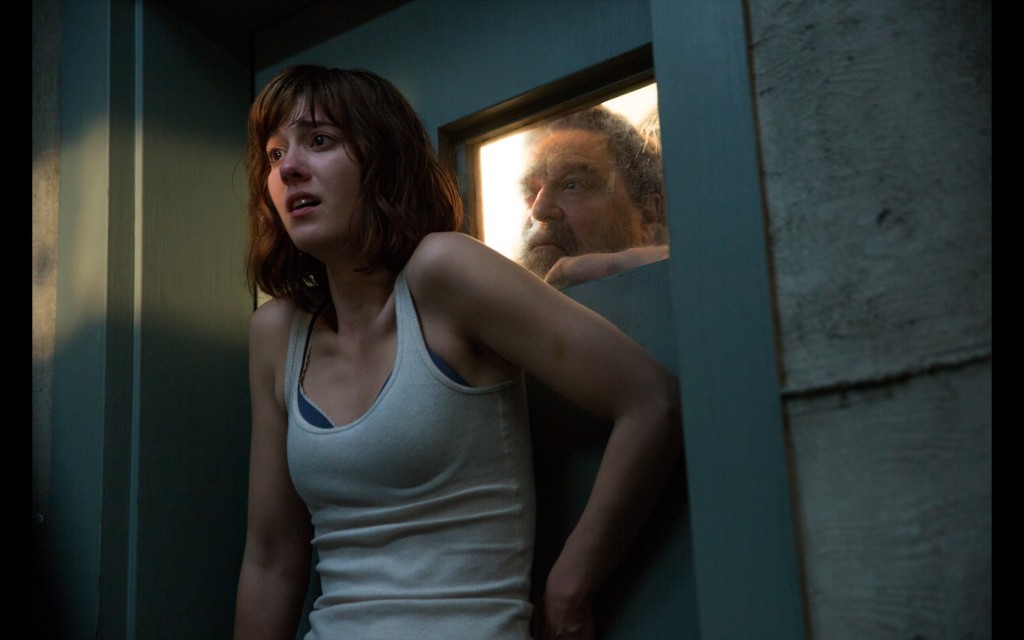“10 Cloverfield Lane” Captivates Audiences with Subdued Intensity

There seems to be an unwritten rule when it comes to sequels. They almost always tend to be bigger, brasher and louder than their predecessors, which is why it’s so refreshing to see an example that defies the expectation. “10 Cloverfield Lane” is a smaller, yet scarier and more intense follow-up to the 2008 found-footage monster movie that is anchored by fascinating performances, clever cinematography, a tight script and story. Bigger doesn’t always mean better.
The movie begins with Michelle (Mary Elizabeth Winstead) packing up and abandoning her life before getting into a shockingly visceral car crash. She wakes up to find herself chained to a pipe in an underground doomsday shelter run by Howard (John Goodman), who tells her that there has been an attack and that almost everyone on the surface is dead. Along with fellow shelter resident Emmet (John Gallagher Jr.), Michelle is left with a dilemma: Is Howard telling the truth, or is he a delusional conspiracy theorist riding the edge of insanity? Are the two mutually exclusive?
The first thing anyone should know about “10 Cloverfield Lane” is that it is not a direct sequel to “Cloverfield” and does not share its found-footage monster movie style. Producer J.J. Abrams refers to it as a “blood relative” or a “spiritual successor.” The story and universe of the movie don’t appear to be tied to the original except for one detail that may or may not be intentional. John Goodman’s character claims to have been informed of the incoming attack because he “worked with satellites” when (spoiler for the original “Cloverfield”) it was a satellite crashing into the ocean that woke up the Cloverfield monster. Knowing J.J. Abrams’ penchant for hiding similar Easter eggs in other films, it’s unlikely that this is a coincidence.
Goodman’s performance as Howard is the standout performance here, and Goodman plays him as an intriguing and disturbing villain. He bounces between tenderness and naked aggression at the drop of a hat, and he manages to seem both extremely competent while dropping small hints that not all is as it seems.
Goodman also brings a unique physicality to the film as uses his massive bulk to great effect by intimidating Michelle and Emmet, oftentimes filling up the shot. Conversely, he manages to get a laugh out of us as he shakes his ample rear end to the beat of uplifting music. You can never be truly sure whether Howard will save the other characters or be their undoing. Howard’s relationship with Michelle is the most intriguing aspect of the movie because the two characters struggle to comprehend and outsmart one another. Goodman has excellent chemistry with Winstead, who is a solid lead and comes across as a real person as opposed to the caricatures that populated “Cloverfield.” Perhaps the most surprising aspect of her character was that she came across as intelligent and rational while navigating the perils of the film, a trait not particularly common in these kinds of movies. Meanwhile, Gallagher’s disarming Southern mannerisms provide welcome moments of light in what is largely a somber movie, but his character is mostly left by the wayside as the focus remains on Howard and Michelle.
What makes “10 Cloverfield Lane” tick is the tension that comes from Michelle’s constantly shifting sense of safety. Director Dan Trachtenberg makes an excellent debut as he constantly toys with her and her perception of the bunker. On one hand, it is a place of tangible and definite safety as opposed to whatever may be lurking on the surface. On the other hand, it’s a prison run by a paranoid wreck with a gun. Even when it appears as though the threat outside is real, Michelle is presented with more evidence that life in the bunker may be even worse.
While three people isolated in a small bunker may sound like an intriguing dramatic premise, it doesn’t promise much in the way of visual drama. However, “10 Cloverfield Lane” defied my expectations throughout. This was largely accomplished by excellent cinematography that consistently found new ways to present the characters in the four rooms that they are present in for 90 percent of the movie. The most recent example of something similar would be 2015’s “Room,” which was largely shot in the titular room. Also, the story ensured that the action of the movie didn’t just revolve around these characters having conversations. As the bunker experiences technical difficulties and Michelle considers escape, the film presents us with one interesting set piece after another.
As tensions mount, the film inevitably proceeds to a violent and explosive third act. However, it comes across as incredibly rushed, with most of the movie’s plot progression taking place in the last 20 minutes. As for the ending itself, the less said about it the better. Still, it’s worth noting that there are certain aspects of it that come out of nowhere and don’t exactly make a lot of sense. Considering the fact that this is a “Cloverfield” movie it is entirely possible that there were hints throughout the movie that I missed and would only catch on a rewatch. After all, I only caught the satellite in the original movie after someone told me it was there.
“10 Cloverfield Lane” is a excellent example of the fact that smaller films can still work in an age of blockbusters. While it may lack spectacle, it still manages to deliver an intense and frightening story and reminds us that humans can be far scarier than a rampaging kaiju.